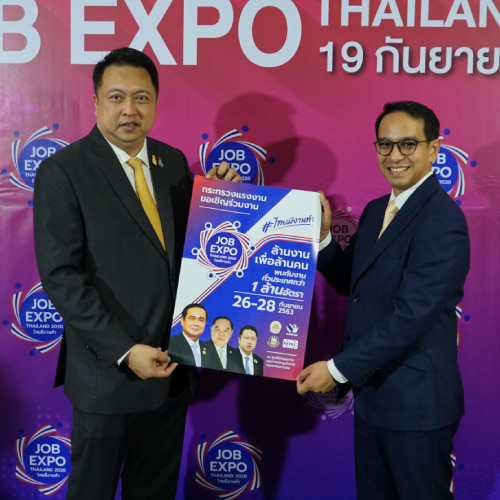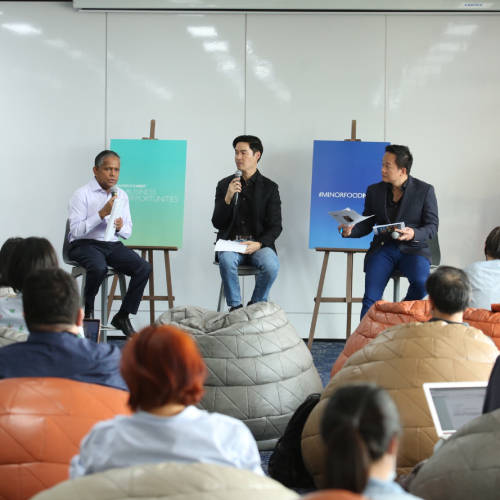Minor Food x The Standard: Episode 1 - Goal-setting (from opportunities, not problems)
Now we live in a time where there is a lot of hustle and bustle going on around us. We also face more competitions everywhere we go. There are many people that tend to work without knowing what they are doing or whether their work is truly an added value to the company. This might result in a wrong goal settings if employees are not aware of the company’s vision and their values.
To iterate that point, K. Jeed - Patamawalai Ratanapol, our Chief People Officer is sharing her relevant experience on a topic that every employee should exercise and commit oneself to.
Let’s have a listen on how we can set ourselves up for success, why daily goal-setting is key, and tips for leaders to assist their employees in goal-settings.
The differences between ordinary employee and extraordinary employee can be as simple as their morning habits. While ordinary employees wake up with a mindset that today is just another one of those mundane 5 days at work. They will do the absolute minimum of what they are required. On the contrary, extraordinary employees wake up with the mindset that they are going to crush the day by giving their all to their jobs. They are willing to contribute the best of their ability, in whatever way they can, towards the company vision.
Successful Goal Setting
1. Think every morning of what you intend to achieve that day. Before you start your day, you need to imagine what a successful day look like. A to-do list will not suffice, you need to actually project how you want your day to turn out.
2. Ask yourself a question--why are you here! When you frequently think about the ‘why’, you most likely will get various fresh and creative ideas.
3. Practice setting goals as actual objectives that are measurable, not as some abstract concept. Try not to set goals that are intangible e.g. happiness, unity, teamwork; but rather tangible and most importantly measurable ones. For example, Human Resource may set ‘employees’ happiness’ as one of the company’s objectives. But in practice, it can be very difficult to execute that. HR will need to find a tangible way to measure employee’s happiness that will be relevant to their work and the company. For instance, provided that when employees are happy, they tend to hit the sales target. Hence, HR must ensure to put in place tangible steps towards achieving such a goal.
Setting Effective Goals For Your Employees
Employees should set effective goals that are aligned with the organisation’s and the business’s. Junior employee may not identify their personal goals with the company’s due to their inexperience and lack of understanding of the overall company’s vision. However, if they take the time to realise that every organisation must have set goals and objectives, and by working for the organisation, employees are already working towards the same goals.
And if the goals were easy to achieve, then we would be no better than who we were yesterday. But if the goals were challenging, we would need to step out of our comfort zone. Because when things are challenging, we may not be able to achieve it easily. It may require us to acquire more knowledge. And this is key to development.
How to Align Your Personal Goals with Organisation Goals
1. Attend business meeting.Try to attend as many executives’ meetings as you can because there are some values in these meetings. You will understand the organisation’s goals and visions clearly for instance.
2. Let your leaders know about your performance development plan. Talk straightforward to your leaders about your future career plan/goals. What you need to develop, or be given the opportunity in order to reach your desired goals. For example, a housekeeper can ask his/her supervisor what the expected level of cleanliness are (e.g. zero rubbish, zero rubbish and scent, or zero rubbish and scent with shinning tap). If you know exactly what your organisation’s expectations are, you can perform accordingly.
3. Observe everything. After we know the company’s goals, we should always keep an eye on any changes or development happening within the company. For example, the company may set to increase more product sales as a year-plan in Q1, but the goal might change to innovation development in Q2. Therefore, employees should always keep a close eye on what the company is doing. So that you can align your goals with the organisation’s new goals easily and effectively.
A Leader’s Guide to Employee Goal-Setting
At Minor Food Group, we use Key Performance Indicators (KPI) to measure employees’ performances. Leaders must set clear and accurate indicators. For example, a manager who manages a team would ask that each team member set 3 goals. The respective team members must report directly to their manager each month whether they have achieved their KPIs. At Minor Food Group, we conduct a monthly report on every 3rd of each month. The report is given colour code to indicate the progress of the project.
• Green : project’s accomplished
• Red : need assistance / advise from managers
• Yellow : in progress
The key is to give freedom to employees in setting their own objectives and KPIs.
Why Some Fail to Achieve Their Goals
Why some people seem to achieve more than others and others seem to fail. That’s because some people forget to take into account what their strengths are. The effective way of setting goals should start from what we do best or what we are good at. In challenging situations, we should always be open to adapt and improve our skills because it’s part of the process for development.
Stop Setting Goals to Solve Yesterday’s Problems
Many companies develop goals to solve yesterday's problems instead of using yesterday’s problems as an opportunity to set new goals. For example, some of our products normally sell well during mid-year which is the rainy season. But we did not hit the sales targets last year due to heavy rain. So, we should take this opportunity to figure out what other companies / competitors are doing differently to achieve their sales targets, when they are also faced with the same problems. Then, we can adapt our plans/strategies accordingly.
Most people often look at problems as obstacles instead of opportunities.
Good leaders should explain and inspire their employees.
- - - - - - - - - - - - - - - - - - - - - - - - - - - - - - - - - - - - - - - - - - - - - - - - - - - - - -
Credit: The Standard Podcast - The Secret Sauce
https://thestandard.co/podcast/thesecretsauce150/
The Secret Sauce, available on Podbean | Apple.Podcast | Spotify | Soundcloud | Youtube | Joox
Or listen on this link :
https://youtu.be/h3pKqUY88yo






